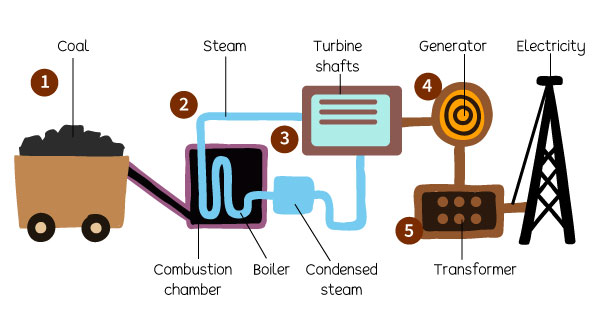- Non-renewable Energy
What is coal?
Coal is a combustible black or brownish-black sedimentary rock composed mostly of carbon and hydrocarbons.
Coal is made of the remains of ancient trees and plants that grew in great swampy jungles in the warm, moist climates hundreds of millions of years ago. The chemical and organic process these dead organisms undergo to become coal is known as Carbonization. Coal is ranked very high if it has undergone a longer carbonization period. An example is Anthracite. Coal that has not undergone too much carbonization is ranked low, and an example is Peat.
How is coal converted into electricity?
Let us take a look at the diagram below:

- Coal is milled to a fine powder and fed into a combustion chamber. In there, it is burnt quickly at high temperatures.
- The hot gases and heat energy produced converts water in tubes lining the boiler into steam.
- The high-pressure steam is passed into a turbine containing thousands of propeller-like blades. The steam pushes the blades causing the turbine shaft to rotate at high speed. The steam is condensed and returned to the boiling chamber, where it is heated again.
- The shaft rotation engages the wire coils and magnets in a generator connected to it. This charged magnetic field produces electricity.
- Electricity is sent to the switchboard (transformer) where it is regulated and sent via on-land cables to homes.
Using coal to produce energy causes many problems, usually on a greater scale than the use of oil or gas. These problems include acid rain, sulfur oxide emissions, carbon dioxide emissions, hazardous waste, and others.
Several forms of coal exist in the world. Anthracite, bituminous coal, lignite, and sub-bituminous coal are all different types that are used by humans.
